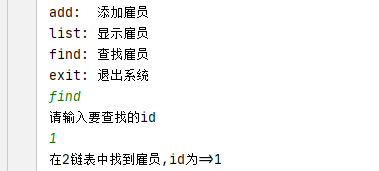Preface
Here's a little cold blog
_Column on High Quality Technology and Good Writing
Personal Public Number, share some technical articles, and pits encountered
Current Series: Data Structure Series
Source code git repository'
Data structure code address Code Git repository address
Hashtable
A basic introduction to hash tables
A Hash table is a data structure that is directly accessed based on a key value. That is, it accesses records by mapping key code values to a location in the table to speed up the search. This mapping function is called a hash function, and the array of records is called a hash list.
Technical Prospect: How to Solve Without Caching Products
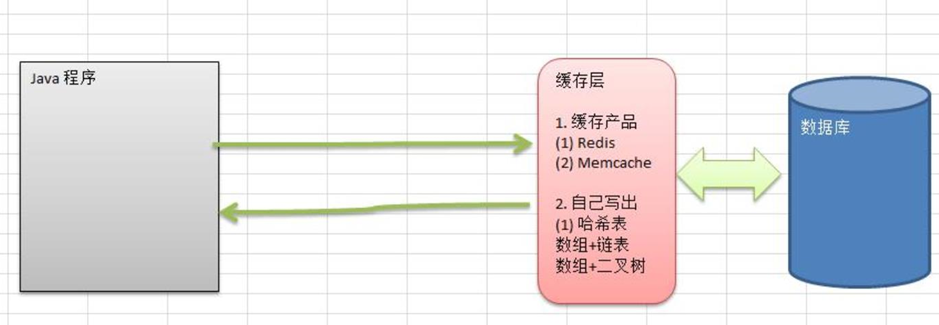
Hash list after graphical implementation
The idea is to use arrays as a unique identifier for mapping, and the index in each array drinks a list of chains
Examples of department numbers can be interpreted as values for arrays
Department number: Name (value saved in the list)
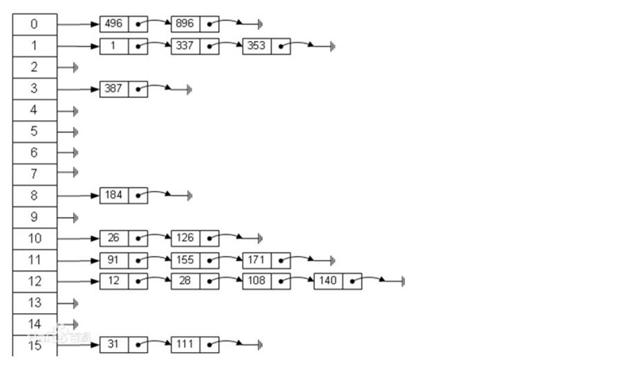
google Topic
There is a company that asks for information about a new employee (id, gender, age, name, address...) to be added when a new employee reports. When an employee's ID is entered, all information about the employee is required to be found.
Requirement:
-
Without a database, the faster the better=>hash table (hash)
-
When adding, make sure to insert id from low to high after class thinking: If id is not insert from low to high, but requires each chain list to be from low to high, how to solve?
-
Use a chain table to implement a hash table without a header [that is, the first node of the chain table stores employee information
Ideas analyze and draw diagrams
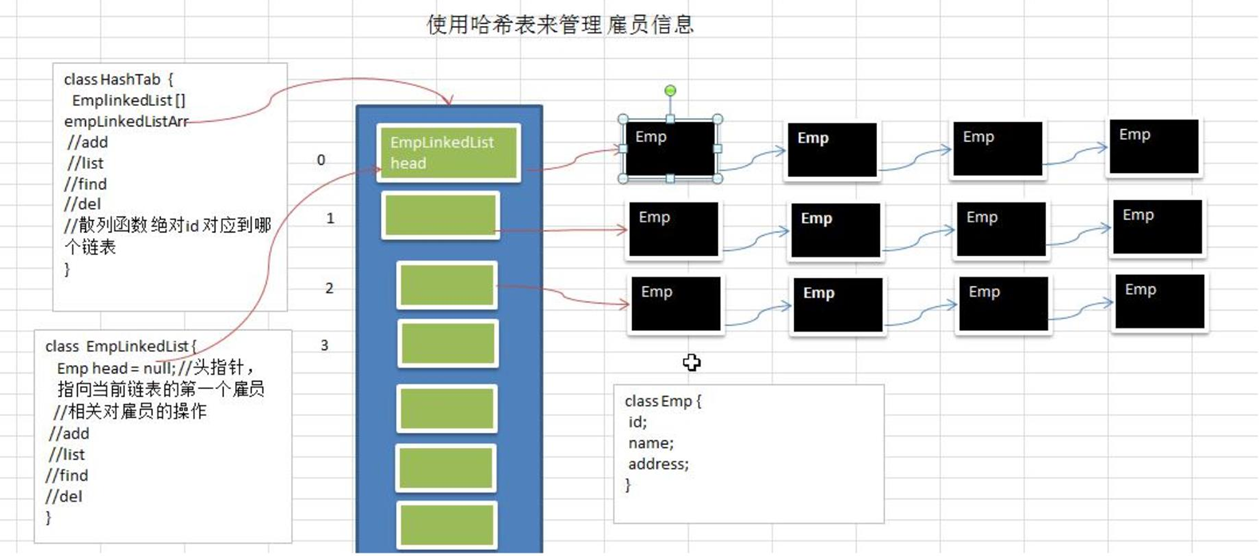
Idea Realization
/**
* @projectName: DataStructure
* @package: com.hyc.DataStructure.hashtable
* @className: hashtebDemo
* @author: Cold ring doomwatcher
* @description: TODO
* @date: 2022/2/1 3:01
* @version: 1.0
*/
public class hashtebDemo {
public static void main(String[] args) {
//Create a hash table
hashtable hashTab = new hashtable(7);
//Write a simple menu
String key = "";
Scanner scanner = new Scanner(System.in);
while (true) {
System.out.println("add: Add Employee");
System.out.println("list: Show Employees");
System.out.println("find: Find Employees");
System.out.println("exit: Exit System");
key = scanner.next();
switch (key) {
case "add":
System.out.println("input id");
int id = scanner.nextInt();
System.out.println("Enter a name");
String name = scanner.next();
//Create Employee
Emp emp = new Emp(id, name);
hashTab.add(emp);
break;
case "list":
hashTab.list();
break;
case "find":
System.out.println("Please enter what you are looking for id");
id = scanner.nextInt();
hashTab.findEmpById(id);
break;
case "exit":
scanner.close();
System.exit(0);
default:
break;
}
}
}
}
//There are two ways to create a hashtab to manage multiple linked lists, that is, to map with arrays
//1. Array + Chain List
//2. Binary Tree
class hashtable {
//Array for mapping a list of chains
private EmpLinkedList[] empLinkedListArrays;
// Used to record length
private int size;
// Constructor Initialization
public hashtable(int size) {
this.size = size;
// Initialize Emplinkedlistarrays
empLinkedListArrays = new EmpLinkedList[size];
// Don't initialize each list separately at this time. We initialize it all at once
for (int i = 0; i < size; i++) {
empLinkedListArrays[i] = new EmpLinkedList();
}
}
// Add Members
public void add(Emp emp) {
// Get the list that the employee should add based on the employee id
int emplinkedlistNo = hashFun(emp.id);
// Add emp to the corresponding list
empLinkedListArrays[emplinkedlistNo].add(emp);
}
//Traverse through all linked lists Traverse hashtab
public void list() {
for (int i = 0; i < size; i++) {
empLinkedListArrays[i].list(i);
}
}
//Find id
public void findEmpById(int id) {
// Use the hash function to determine which chain list to go to
int empLinkedListNo = hashFun(id);
Emp empByid = empLinkedListArrays[empLinkedListNo].findEmpByid(id);
if (empByid == null) {
System.out.println("No employees found");
} else {
System.out.println("stay" + (empLinkedListNo + 1) + "Employees found in the list,id by=>" + empByid.id);
}
}
// Use modularization to calculate the id array of the corresponding mapping of the chain table based on the id
public int hashFun(int id) {
return id % size;
}
}
class Emp {
public int id;
public String name;
public Emp next;
public Emp(int id, String name) {
this.id = id;
this.name = name;
}
}
class EmpLinkedList {
//Header pointer, executes the first emp so the head er of our list is directly pointing to the first emp
private Emp head;
// Add Employees to List
// 1. Assuming that when you add an employee, the id always increases from small to large, so we don't need to handle the judgment of whether the ID is in order.
// Add directly to the end of the current list
public void add(Emp emp) {
//If the header node is empty, add it because it is the first employee
if (head == null) {
head = emp;
return;
}
// If the header node is not empty that means it is not the first one, we need a pointer to the header node
Emp curEmp = head;
// Loop the list to the end
while (true) {
//If you enter this if then the list is at the end
if (curEmp == null) {
break;
}
//Each loop moves curEmp back until it triggers if to break
curEmp = curEmp.next;
}
// Exiting the loop means curEmp is the last one, so here we'll point next to emp for the parameter
curEmp.next = emp;
}
// Traverse a list of chains, the parameter is used to determine which one belongs to
public void list(int no) {
if (head == null) {
// Entering this judgment indicates that the chain list is empty
System.out.println("No." + (no + 1) + "Chain list is empty");
return;
}
System.out.print("No." + (no + 1) + "The current list information is");
Emp curEmp = head;
while (true) {
System.out.printf("=>id%dname=%s\t", curEmp.id, curEmp.name);
if (curEmp.next == null) {
break;
}
curEmp = curEmp.next;
}
System.out.println();
}
//Find a list of chains based on id
public Emp findEmpByid(int id) {
if (head == null) {
System.out.println("The list is empty");
return null;
}
Emp curemp = head;
while (true) {
if (curemp.id == id) {
break;
}
if (curemp.next == null) {
System.out.println("There are no employees to look for in this list");
break;
}
//Move back
curemp = curemp.next;
}
return curemp;
}
}
Effect demonstration
New and Traversal
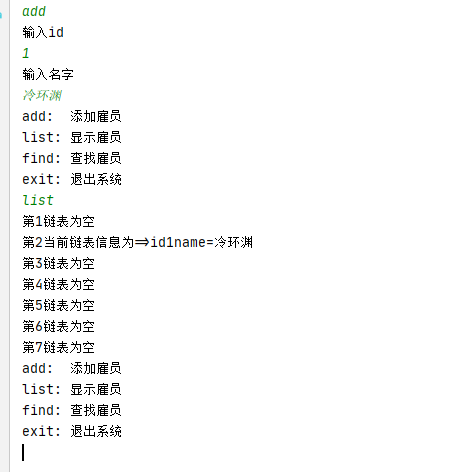
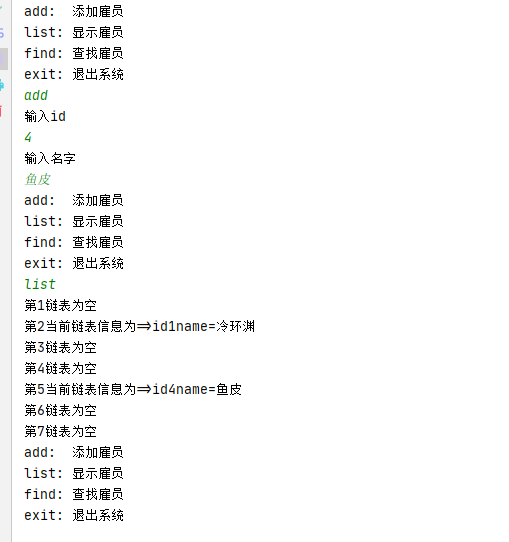
lookup
